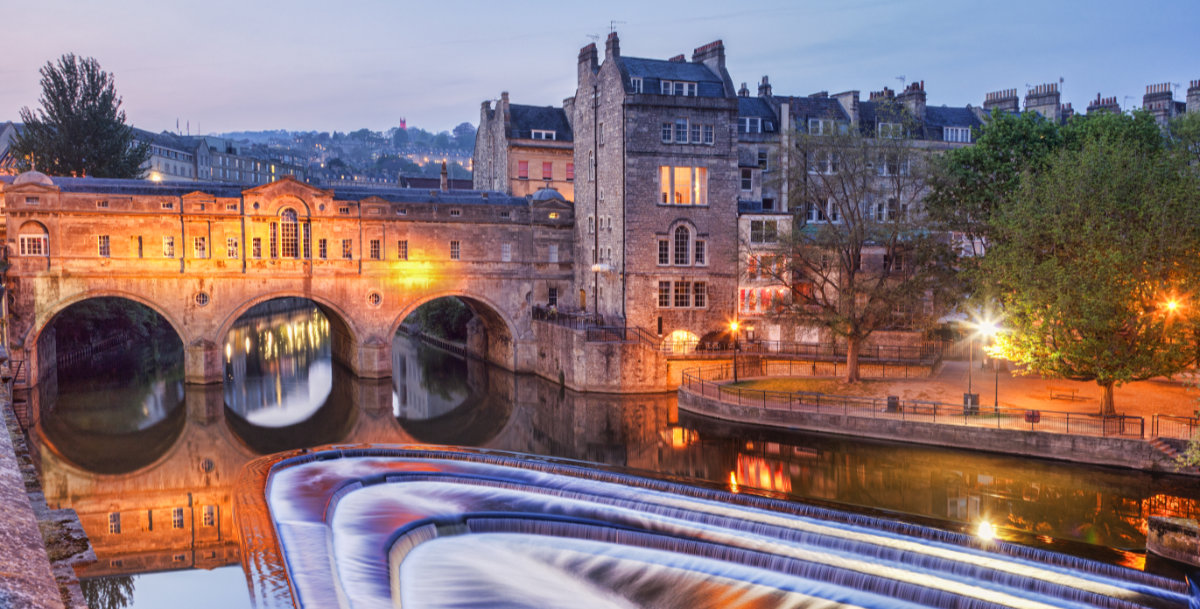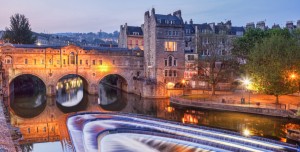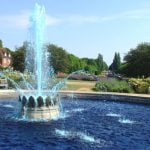
Everything you ever wanted to know about Bath, in under 5 minutes!
Bath has always been known as a Roman town, but its history goes beyond that. Furthermore, it is a lovely part of the countryside that is ripe for visiting. If you are trying to choose somewhere for your 2021 holiday, we couldn’t recommend anywhere better.

Image:travellight/Shutterstock.com
Let’s take the Five Minutes Spare tour of Bath and see where we come out. We are excited to review this ancient town. The Romans were bloodthirsty conquerors – but they sure knew how to build.
Bath in the Early Days
Bath is the ultimate bath town, even named for its purpose back in Roman times. The beneficial properties of the hot mud and springs here were known as long ago as 860 BC when legend has it that King Lear’s father bathed in mud when he saw it cured pigs of a skin disease in the town. He went on to become king and when he did, he found Bath.
Before this, the area surrounding Bath had seen use since the Mesolithic period. Archaeologists believe that the area the Romans used as a bath was actually a shrine of the Britons before that.
We can be certain of the Romans loving the town. They arrived in 1 AD and built a temple dedicated to the Goddess of Healing, Minerva. They also dedicated it to a Celtic God named Sul. Later, a bath would grow around the temple, with stables and inns needed to accommodate said baths. Some sources have their arrival as 50 AD, but whenever they came, they left a town in their wake. The town is now a UNESCO world heritage site due to the Roman remains and Georgian architecture which came much later.
The baths and temple have seen rich archaeological findings in recent years. Curse tablets are some of the most interesting finds. They were grievances written on tablets and left for the goddess. The building of the baths took about 300 years to complete. The town was given walls in the 3rd century, but it was all left behind when they retreated back to Rome. A 2012 dig saw a Roman hoard of 30,000 coins uncovered.
After the Romans left…
The Romans were gone by 407 AD, leaving the town to grow in Saxon hands. It is believed this area may have been the sight of the Battle of Bodun, in which King Arthur saw off the Anglo-Saxons. In the 9th century, Alfred the Great made Bath one of his fortified towns from whence he could rule all England, then in 973, Edgar was crowned the first king of England, not in London: but in Bath.
In the 9th century, Bath had its own abbey which was built in 781 and was dedicated to St Peter. When Alfred the Great re-designed the town in the 900s, he gave the whole of the southeast to the abbey. He turned it into a burh with a wall over a thousand yards in length. It was defensible by 1000 men. Edward the Elder had coins minted here, so there must also have been smelters and a mint.
The name ‘Bath’ came from the Anglo-Saxon name of Badum. It is mentioned in the Domesday Survey as being the ruling town of its hundred, with 154 burgesses that earned a whopping 66 pounds, 1 shilling and 12 pence. The land was owned by the King, proving that it hadn’t changed hands from royalty yet, even if it had passed between invaders.
By the 12th century, the abbey just about dominated the whole town. The building that stands now dates from the tail end of this period. In 1499 the Bishop of Bath had a dream of angels ascending to heaven on ladders and took it as a sign to rebuild the fragile abbey. The church ran two alms-houses to help the poor, but the rest of the town still made its money out of the baths.
Bath Receives A Charter
The town received its first official charter in 1189, which would have let them hold a market. Wool cloth was fulled and dyed here in medieval times and the baths would have brought trade, too. Henry VIII closed all the abbeys in his time in 1539, leaving the town suddenly bereft of half of its people. By the 17th century, it was almost wholly dependant on sick people coming to seek the cure of the baths and the mud.
Bath got a second charter in 1590 by Queen Elizabeth which made it into an official city. In 1633 they banned thatching because of the fire hazard, and as of 1615 the streets were routinely cleaned. Bath suffered from the plague back in the 1300s, but then again throughout the 17th century. They were struck in 1604, 1625, 1636 and again in ’43. 1642 saw the English Civil War and Bath was occupied by the Parliamentarians, which resulted in a battle in which the Royalists won. However, by 1645 the king had lost and the Royalist commander in Bath surrendered the town. By the end of the century, all was quiet again. Someone had the ingenious idea to bottle and sell Bath water, and a trade arose there.
Much of Bath was then rebuilt in Georgian times and the Tudor period, which makes it cherished nowadays by UNESCO. A quarry nearby sported a creamy coloured stone which made most of the buildings and new streets. The Prior Park Estate was built out of this stone in the same period.
Let’s take a break from the history for a moment and look at some fun trivia out of Bath. It’s been a daunting few hundred years and we need a break.
Fun Trivia About Bath
The town of Bath is old enough and pretty enough to have had thousands of little fun things happen in its streets. Here are some of the Five Minutes Spare favourites for you to share with your friends:
- The aforementioned Roman hoard of coins we mentioned earlier was the largest ever to have been found in Britain.
- In 1942, Hitler carried out a deliberate bombing raid on Bath in a deliberate attempt to destroy one of Britain’s oldest treasures. Many of the bathhouses were damaged and the Assembly Rooms needed to be rebuilt. It was known as the Bath Blitz. The Blitz destroyed 19,000 buildings, meaning the town has been largely rebuilt.
- Uranus was discovered in Bath… well… not in Bath, but you know what we mean. William Herschel spotted it through a homemade telescope in King Street, in 1781[i].
- The Saracen’s Head pub was established in the early 18th century and has the unique claim to fame of once hosting Charles Dickens.
- The stamp was not invented in Bath, but it was first used here. The world’s first stamped letter was posted with the Penny Black stamp, a huge innovation of its time.
Bath is a much more interesting place than we thought it was going to be! Let’s turn our attention to Industrial Era Bath and see if it was hurt by the Revolution.
Industrial Revolution and Victorian Era Bath
Bath was paved and cleaned as of 1718 and the first hospital was added in 1742. A bank was opened in 1768 and the Sydney Gardens arrived in 1795.
The early 18th century saw the erection of the first theatre and many other fine buildings. The Circus was built by John Wood the Elder in 1727. Rumour has it that he built it off of a design of Stonehenge. He also built Queen Square, Royal Crescent, The Assembly Rooms, The Octagon, and the Margaret Chapel. The Pulteney Bridge was added in 1774.
In 1801 the city had a population of 33,000, which was already big. Throughout the century it would swell to 66,000, even although the importance of the baths lessened. When the trains were introduced, the townsfolk were able to travel to the coast and country, so Bath became less touristy.
In 1805 there was a theatre added, the Kennet and Avon Canal arrived five years later, and the park was built in 1830. The Victorians loved a good park. The railway track arrived in 1840, connecting the town to London the next year. There was a cholera outbreak in the overcrowded city in 1849. 1880 saw trams on the streets and archaeologists dug up the old baths from Roman times. Another Park was added by 1897 and, at the end of the century, they had electricity.
Modern Bath History
The 20th century saw electric trams replace the horse-drawn ones. Council houses were built as of 1907 to clear the slums, but more were added in the decades following the first world war. Many young men from Bath went off to war and didn’t return. More of their youth died in WWI than in WWII. Some 1174 young men went off to die in the trenches compared to only 602 in the Second World War. As we know, Bath was bombed extensively in WWII. Leading to a further 402 civilian deaths.
In 1961 the Bath at Work Museum arrived in 1978[ii]. The Postal Museum was founded in ’79 with a museum devoted to the late Herschel and his discovery of Uranus in the following years. There are numerous museums in Bath, we’re not even going to cover them all because it would take all day.
Modern Bath has seen the addition of shopping centres and farmer’s markets. It has seen new builds meet old builds, protected architecture restored, and many green spaces added. It is a picturesque city that is much adored as both a city break destination and as a UNESCO site. It is one of the richest Roman towns that we still have and should be preserved. So go there, spend freely, encourage that tourism, and help get the UK back on its feet again.
Never was there a better place to staycation in, than Bath. But before we get stuck into the attractions, let’s talk about the famous people you might meet if you are on holiday there…
Famous People from Bath
We are going to omit the obvious ones like William Herschel and move straight on to the ones that are a little less well-known. Starting from the 20th century wouldn’t hurt, either. Here are the Five Minutes Spare favourite famous folk from Bath for your amusement:
- Bill Bailey comes from Bath
- Mary Berry, the Chef of Great British Bake Off, is from Bath
- Andrew Lincoln, that’s Rick in The Walking Dead, grew up as a Bath man.
- Tim Curry, who played the lead in The Rocky Horror Picture Show, is Bath born.
- Anne Widdecombe is from Bath. We guess you can’t win ‘em all.
And on that note, let’s get to the part we have all been waiting for: the best things to see and do in Bath!
Bath Attractions
The best things to see and do when you are in Bath for a few days are listed below.
Historic Sights and Landmarks
The first thing you think of when you think of Bath is the Roman baths. The Baths are restored and 2000 years old. They have school tours and virtual sessions on offer and have become a museum more than a place where you take a dip to cleanse yourself of plague… though given recent world events we are surprised nobody tried it. They take you through the history, tell you about the Romans, and you get to tour a place where people relaxed naked 2000 years ago.
A second historical attraction and landmark that sets Bath aside from other cities, is that fabulous Abbey. Although Henry VIII closed it down, the building was later restored by the church. The Abbey is still in use and sports some iconic stained glass windows. It’s beautiful even just to take pictures of and walk around.
There are plenty of architectural masterpieces to browse if you walk around this city. One of them is the Circus, a ring of townhouses designed by John Wood the Elder in the 18th century. They are beautiful to look at and in their symmetry.
Outdoor Attractions
There are plenty of Victorian and Georgian parks placed around the town, too. One of the most famous is the Royal Victoria Park, which you can find a short distance from the town centre. Princess Victoria came to Bath in 1830 where someone made a disparaging comment about how thick her ankles were. She never returned… or so the story goes.
If you don’t like the Royal Victoria Park, there is the Prior Park on the Prior Estate for you to enjoy. It is perfectly landscaped complete with a pond and gazebo-bridge. It’s run by the National Trust, so give generously. It was created in the 18th century in that same elegant style. You can sunbathe there, but grannies would look at you funny. Maybe best to wander and enjoy the sights, instead.
If you prefer a bit of exercise and want to get out of the city, or even if you just want to sunbathe someplace that you won’t get judged, you should head to Little Solsbury Hill. This local landmark gives excellent views over the city, where you can count every spire and Georgian building on a clear day. It is only 191m up, so it really is a little hill.
Galleries and Museums
One of the top-rated attractions in town is the architecture and parkland found at No 1 Royal Crescent. As well as being gorgeously built in the striking Georgian style, this house is a part museum. It has been outfitted entirely in the period style and is considered to have been one of the most important houses in Bath in the 18th century. The rest of the crescent is pretty too and well worth the walk.
The Fashion Museum is one of the coolest things to see and do in Bath. It’s always great to have a peek back through history in an interesting way and this museum certainly allows you to do that. By showing you the clothing of the times, you get to see how our predecessors lived. They have interactive exhibits that explore fashion through the ages. When you put Victorian gowns across the hall from 70s thigh-highs it really sparks the imagination.
Part Museum, part delightful Sydney Gardens, pay a visit to the Holburne Museum if you want to see a building that is worthy of Instagram. They have gardens, exhibits and a café for you to enjoy. It is a Grade I listed building and simultaneously the city’s first art museum/gallery. See local collections, enjoy the artworks of masters, and generally enjoy the atmosphere. The other art gallery worth visiting in town is the Victoria Art Gallery, which is smaller but with a fine collection. It takes its name by being on the edges of the Royal Victoria Park.
Sports and Recreation
The local football team is Bath City FC, although there are lots of smaller football clubs in town, including the Bath Arsenal Juniors team, the Radstock Town Football Club, and the Keynsham Town Football Club. The Team Bath FC is associated with the University.
If football isn’t your game, then there is always a golf club in any given English town. Choose from Bath Golf Club or the Lansdown Golf Club which is slightly farther out in the country.
There is a range of other recreational activities in Bath, but one that stands out is the Magic Theatre. Krowd Keepers is its own little delight waiting for you to visit and see a real live magic show. It’s great for kids and adult’s kind of love it, too.
Shopping and Retail
One of the best shopping areas in town is the Pulteney Bridge which isn’t just a bridge. It is both a striking example of Georgian architecture and a flea market beside a beautiful fountain. It has some of the best shopping in the city. If they don’t have what you are looking for, you should be able to find it at the SouthGate Bath Shopping Centre, instead.
Other Things to See and Do in Bath
We couldn’t fit in all we wanted to because Bath is so tourist-driven. However, if you are staying for long enough, here are some of the other sights we feel you ought to try and see:
- There are always more museums to see in Bath. The American Museum and Gardens is another must-see sight… then there’s the Herschel Museum,
- Take a stroll down Bath Street to appreciate the architecture.
- Visit Alexandra Park to have a picnic.
- The Jane Austen Centre is a nice place to learn about literature.
- Visit the Theatre Royal and see a show.
- Take a tour of the fully restored Roman Assembly Rooms, as bombed in WWII.
- Take a trip out to nearby Farleigh and see the Hungerford Castle remains.
You should be able to keep yourself entertained here no matter how long you are staying for. There is an endless list of things to see and do. Try to have fun and book a second visit if you skip stuff the first time around.
How to Get to Bath
We’ve almost covered everything you need to know about this fabulous city, so here is the last piece of the puzzle: how you get there.
By Road
Head southeast out of Bristol on the A36.
By Rail
The full name of the railway station in the town centre is Bath Spa.
By Air
Bristol Airport is within an hour of Bath.
By boat
You may sail up the Kennet and Avon Canal
[i] https://visitbath.co.uk/blog/ten-little-known-facts-about-bath/
[ii] https://localhistories.org/a-history-of-bath/





